Rare disease organizations helped us on our AADC deficiency journey
How the support our family received has inspired us to help others

When our daughter, Rylae-Ann, was 18 months old, my wife, Judy, and I learned she had a rare disease known as aromatic l-amino acid decarboxylase (AADC) deficiency. As of 2020, only about 135 cases of AADC deficiency had been described worldwide. Thankfully, though, a vast network of nonprofit organizations welcomed and supported us.
After our daughter received gene therapy, she improved so much that Judy and I no longer had to be 24-hour caregivers. We wanted to use the extra time in our days to give back to the rare disease community that supported us. We thus took an ambitious step and established Teach RARE, a nonprofit organization that provides free educational services and resources for caregivers in the rare disease community.
On April 1, we celebrated the first anniversary of our organization’s incorporation — the same date as our daughter’s birthday. Incorporating was a relatively straightforward process. However, managing our organization and working to make it successful is quite another story.
According to the National Association of Nonprofit Organizations & Executives, about 30% of nonprofits fail to exist after 10 years. Judy and I are full-time educators, so taking on this new project has been very challenging — but we believe in its mission.
Thankfully, several other organizations supported us in our first year.
Patient Worthy
Patient Worthy is an online resource for rare disease patients, caregivers, and advocates. The stories shared on its website have inspired and motivated us. Judy and I found parents caring for their children while fighting to stay healthy themselves. It meant a lot that Patient Worthy reached out and interviewed us to get our family’s full story.
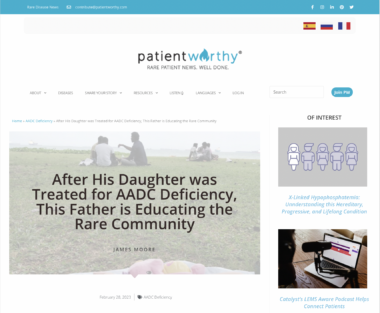
The Poulin family was inspired by stories from other caregivers. Today, Richard and Judy hope their story will give hope to other families. (Screenshot via patientworthy.com)
Rare Revolution Magazine
“Mom, we are in a magazine!” I remember texting.
Rare Revolution Magazine aims to give a voice to rare disease patients. In addition to featuring Teach RARE in the digital magazine and on the website, team members also had us join their #TakeoverTuesday project. During our assigned Tuesday, we got to make posts on the magazine’s social media platforms. It was fun, but there was some anxiety knowing we were at the helm for the day.
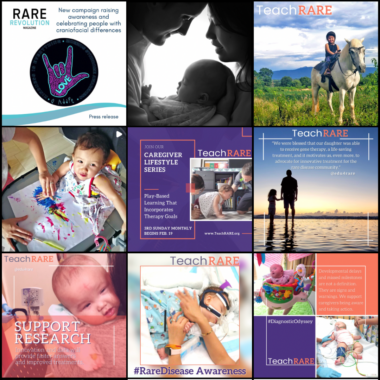
A screenshot of Teach RARE’s #TakeoverTuesday project with Rare Revolution Magazine. (Screenshot via instagram.com)
Rare Disease Day
Rare Disease Day (RDD) was established in 2008 by EURORDIS (Rare Diseases Europe), a nonprofit alliance of more than 1,000 rare disease organizations from 74 countries. While RDD is observed on the last day of February each year to generate awareness for rare diseases, it’s also a movement coordinated by EURORDIS and more than 65 national alliance patient organization partners.
It was an honor to have our family’s story featured on the website and to have Teach RARE become a registered friend. RDD has also featured some of our online events. Being included in this network is an honor.
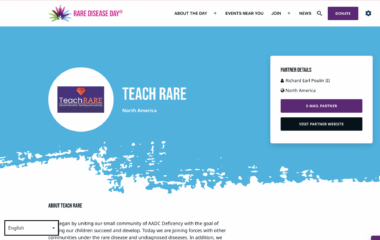
In addition to sharing the Poulin family’s story, Rare Disease Day also features Richard and Judy’s nonprofit organization, Teach RARE, and its events. (Screenshot via rarediseaseday.org)
SENIA International
Judy knew about SENIA, or Special Education Network & Inclusion Association, from her experience as a special education teacher. SENIA is a network of parents, teachers, professionals, and students that provides resources for those with rare diseases and disabilities as well as training for inclusive education.
After Rylae-Ann’s AADC deficiency diagnosis, Judy immediately reached out to learn about resources and strategies we could incorporate at home. The network was also critical in helping us achieve our mission at Teach RARE of combining therapy strategies with education. SENIA International hosted us on its podcast and shared our mission with its large network of international educators.
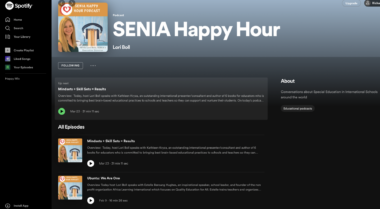
SENIA International supported Teach RARE’s mission. (Screenshot via Spotify)
Child Neurology Foundation
Since our daughter’s diagnosis, Judy and I have been avid readers of the Child Neurology Foundation (CNF) website, so we were excited to contribute our story. The foundation is a network that connects people in the pediatric neurology community. The CNF team supported us in navigating our rare disease journey, and it was an honor to do the same for others. In addition, sharing our story helped us get our message out to the foundation’s large community.
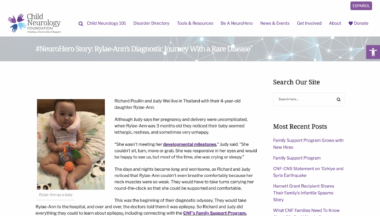
Child Neurology Foundation stories and resources supported Richard and Judy as they began their rare disease journey. Today, they seek to do the same for other families. (Screenshot via childneurologyfoundation.org)
Note: AADC News is strictly a news and information website about the disease. It does not provide medical advice, diagnosis, or treatment. This content is not intended to be a substitute for professional medical advice, diagnosis, or treatment. Always seek the advice of your physician or other qualified health provider with any questions you may have regarding a medical condition. Never disregard professional medical advice or delay in seeking it because of something you have read on this website. The opinions expressed in this column are not those of AADC News or its parent company, Bionews, and are intended to spark discussion about issues pertaining to aromatic l-amino acid decarboxylase deficiency.








Leave a comment
Fill in the required fields to post. Your email address will not be published.